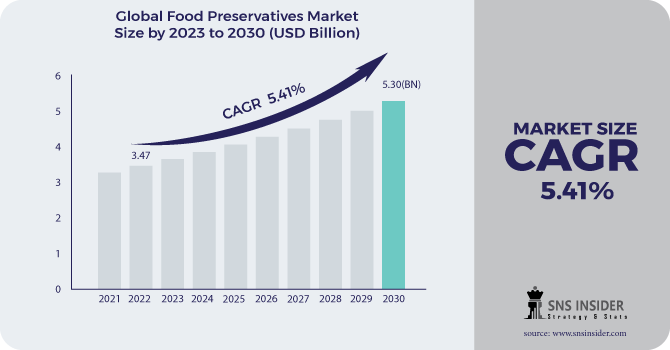Food Preservatives Market Report Scope & Overview:
The Food Preservatives Market is expected to grow from USD 3.47 billion in 2022 to USD 5.30 billion by 2030, at a CAGR of 5.41% from 2023 to 2030.
Food preservatives are the items integrated during food handling to build its strength and to stay away from waste. They are included little proportion to different sorts of food relying upon the need. Customarily, salt, sugar, and flavors were utilized to save meat and other food types.

Get More Information on Food Preservatives Market - Request Sample Report
Food preservatives forestall the development of microorganisms and in this manner restrain or defer food waste. Contingent upon the level of poisonousness, they are characterized as non-harmful and reasonably harmful. Non-poisonous preservatives that can be utilized in the handling while tolerably harmful are directed by significant administrative bodies like the U.S. Food and Drug Administration (FDA) and European Food Safety Authority (EFSA) and are distinguished by fitting list (INS or E) numbers.
A pattern these days in the food preservatives market is the expansion in the utilization of normal preservatives got from plants and creature sources. Prior, manufactured preservatives were liked, as they were successful. As of late, customers have changed to food sources that are sans preservatives, and natural food items. This is making the food business foster preservatives that are comparable to regular ones. There is a rising revenue in the utilization of fixings, for example, catalysts and live societies to protect food items that have fostered the natural preservatives market.
Market Dynamics:
Market drivers:
Expansion popular for food items with a lengthy time frame of realistic usability
Expanded work hours have particularly changed shoppers' ways of life, and thus, their dietary patterns. These progressions are requesting food items that give helpful utilization and a longer period of usability. Henceforth, the job of food preservatives is turning out to be progressively significant in the food and drink industry. The developing interest in food sources with an expanded period of usability profoundly affects the food handling industry. Generally speaking, the all-around demonstrated capacity viability, because of preservatives, has further developed food conveyance techniques, cutthroat evaluation, and increased the value of food items.
Market Restraints:
Expansion popular for natural food items and restricted accessibility of normal preservatives
Despite their significant job in sanitation and time of usability augmentation, the inclination for natural preservatives over manufactured ones is ending up difficult for additive clients in the food and drink industry. Purchaser discernment is that normal food sources are more grounded than those with engineered preservatives. As a sign of this, development in the U.S. cheddar industry is being driven by natural cheddar as buyers search out more excellent food sources. Inside the food business, princely customers are searching for high-quality, handmade, and little clump food varieties. Inside the cheddar business, big-league salary buyers look for natural cheddar that tastes more extravagant profile than handled cheddar with engineered preservatives.
The job of natural preservatives is turning out to be more significant because of the continually expanding interest in normal food items. After the monetary downturn in 2008, the shipment of natural food items in the U.S. recorded a critical lift through 2010. Likewise, buyer interest for food varieties containing decreased compound preservatives is turning into another market an amazing open door for natural preservatives, for example, nisin and natamycin. In the U.S., natural preservatives are utilized in mix with substance preservatives in applications like dairy and frozen food sources and normal preservatives are presently being utilized exclusively in new assortments of food sources like frankfurters. The application extent of natural preservatives is progressively developing, reaching out to prepared food varieties, meat, and accommodation food items.
Be that as it may, there is restricted access to natural sources; normal preservatives, for example, nisin and natamycin are somewhere multiple times costlier than compound preservatives. Numerous natural preservatives are yet to be produced for a bigger scope. The commercialization of assembling cycles of normal preservatives is additionally yet to occur. When the normal preservatives are broadly popularized, their portion in the worldwide food preservatives market would right away increment. Great and solid wellsprings of excellent normal preservatives are being contemplated and many tests are being done to look at their viability to keep up with food quality.
Market Opportunities:
Developing business sectors in Asia-Pacific and Africa
The developing worldwide populace is coming down on makers for the production, extraction, and support of scant assets. High energy costs and rising unrefined substance costs are affecting food costs, hence influencing low-pay shoppers. The strain on food supplies is being exacerbated by water deficiencies, especially across Africa and Northern Asia. Propels in science and innovation are helping in expanding the time frame of realistic usability of food varieties indeed. The requirement for promoting food preservatives to the littlest of food and refreshment producers will help in enlarging the market size.
In developing business sectors, where ways of life are evolving quickly, the interest in working environments and homes is seriously expanding, prompting a more noteworthy inclination for comfort. Inexpensive food will progressively become separated from unhealthy food as we look for choices that are fast and simple, yet sound.
Guardians will progressively need clean name items for their youngsters. Re-plan could be quite difficult for the food and drink industry. The straightforwardness of fixings and the shortfall of counterfeit preservatives may decidedly affect the newness or compactness of kids' food. Recognizing fixings with normally high health benefits could be a vital chance for providers and makers.
Throughout the long term, the expansion in urbanization and globalization has prompted development in education and openness to created countries by means of unfamiliar media, abroad work encounters, and travel. This has achieved a have an impact on in the attitude and inclinations of metropolitan individuals. Expansion in the number of inhabitants in working ladies and predominance of atomic twofold pay families, particularly in metropolitan regions, are different patterns forming the evolving ways of life. Occupied ways of life and changing utilization designs have prompted an expansion in the interest for handled, prepared to-cook, and prepared to-eat food, prompting expanded brand awareness.
Market Challenges:
Well-being risks of synthetic preservatives
A significant test in the food preservatives industry is the Well-being risks caused because of the utilization of manufactured preservatives. Dried and got dried out food varieties frequently contain sulfites. This kind of additive aide’s light-hued food varieties, for example, brilliant raisins or squashed potato chips hold their light appearance. FDA assessed that more than 1,000,000 asthmatics are touchy or susceptible to sulfites. Side effects connected with sulfite utilization remember trouble for breathing, hives, stomachache, and anaphylactic shock. The Food and Drug Administration (FDA), in 2013, endorsed in excess of 3,000 food added substances for use in the U.S. Nonetheless, while endorsed for human utilization, food added substances might in any case undermine our Well-being. This is one of the many justifications for why individuals pick insignificantly handled and treated food sources.
The cell reinforcement, butylated hydroxyanisole (BHA) checks waste in cereals, oils, and food sources that are high in fat. Notwithstanding, when consumed in high measurements, BHA can prompt growth. The Asthma and Allergy Foundation of America in 2005 revealed that the two food preservatives— BHT and BHA — have been connected to persistent hives and different skin responses. These preservatives are added to breakfast oats and grain items to safeguard their variety, flavor, and smell.
Impact of Covid-19:
As per the Freedonia Group report, frozen meat, poultry, and fish (MPS) deals were up during the pandemic for customers, requests in the foodservice market fell pointedly, thwarted by eatery terminations and decreased foodservice business for 2020 in general. Meat preservatives help to control decay by repressing the development of microorganisms, easing back enzymatic action, and forestalling the oxidation of unsaturated fats that advance rancidity. Retail deals of frozen meat, poultry, and fish soar in the early long stretches of 2020 during the lockdown. This was expected generally to raise interest for frozen food varieties as shoppers arranged more suppers at home, expanded their advantage in having a load of durable food sources at home, and looked for frozen food sources as a component of that amassing or expanded home cooking.
During the pandemic, there was a fast development of the pastry shop industry, and shoppers' shift toward arranged suppers to-go in staple has fundamentally added to the interest for food preservatives. The makers are presently zeroing in on various send-offs of plant-based food preservatives to satisfy the more current interest and intrinsic necessities of the bread kitchen industry.
Key Market Segments:
By Type:
-
Natural
-
Synthetic
By Application:
-
Meat & poultry
-
Seafood
-
Snacks
-
Bakery and dairy products
-
Fruit
-
Vegetables
-
Beverages
By Source:
-
Plant
-
Microbial
-
Mineral
-
Animal
By Product Type:
-
Microbial Derived
-
Nisin, Natamycin
-
Rosemary Extract
-
Botanical Extracts
-
Natural Acids
-
Salts
By Form:
-
Powder
-
Liquid
By End-Use Industries:
-
Foods & Beverages
-
Pharmaceutical
-
Textiles
-
Petrochemicals
-
Adhesives
.png)
Get Customized Report as per Your Business Requirement - Request For Customized Report
REGIONAL COVERAGE:
- North America
- USA
- Canada
- Mexico
- Europe
- Germany
- UK
- France
- Italy
- Spain
- The Netherlands
- Rest of Europe
- Asia-Pacific
- Japan
- south Korea
- China
- India
- Australia
- Rest of Asia-Pacific
- The Middle East & Africa
- Israel
- UAE
- South Africa
- Rest of Middle East & Africa
- Latin America
- Brazil
- Argentina
- Rest of Latin America
Key Players:
Kerry Group, Food chem International , Kemin industries, BASF SE, Cargill, Jungbunzlauer Suisse AG, Galactic, Tate & Lyle, IFF Nutrition and Bio sciences, ADM
Kemin industries-Company Financial Analysis

| Report Attributes | Details |
|---|---|
| Market Size in 2022 | US$ 3.47 Billion |
| Market Size by 2030 | US$ 5.30 Billion |
| CAGR | CAGR 5.41% From 2023 to 2030 |
| Base Year | 2022 |
| Forecast Period | 2023-2030 |
| Historical Data | 2020-2021 |
| Report Scope & Coverage | Market Size, Segments Analysis, Competitive Landscape, Regional Analysis, DROC & SWOT Analysis, Forecast Outlook |
| Key Segments | • by Source (Plant, Microbial, Mineral, Animal) • by Product Type (Microbial Derived, Nisin, Natamycin, Rosemary Extract, Botanical Extracts, Natural Acids, Salts) • by Form (Powder, Liquid) • by End Use Industries (Foods & Beverages, Pharmaceutical, Textiles, Petrochemicals, Adhesives, Others) |
| Regional Analysis/Coverage | North America (USA, Canada, Mexico), Europe (Germany, UK, France, Italy, Spain, Netherlands, Rest of Europe), Asia-Pacific (Japan, South Korea, China, India, Australia, Rest of Asia-Pacific), The Middle East & Africa (Israel, UAE, South Africa, Rest of Middle East & Africa), Latin America (Brazil, Argentina, Rest of Latin America) |
| Company Profiles | Kerry Group, Food chem International , Kemin industries, BASF SE, Cargill, Jungbunzlauer Suisse AG, Galactic, Tate & Lyle, IFF Nutrition and Bio sciences, ADM |
| Key Drivers | •Expansion popular for food items with a lengthy time frame of realistic usability |
| Restraints | •Expansion popular for natural food items and restricted accessibility of normal preservatives |

